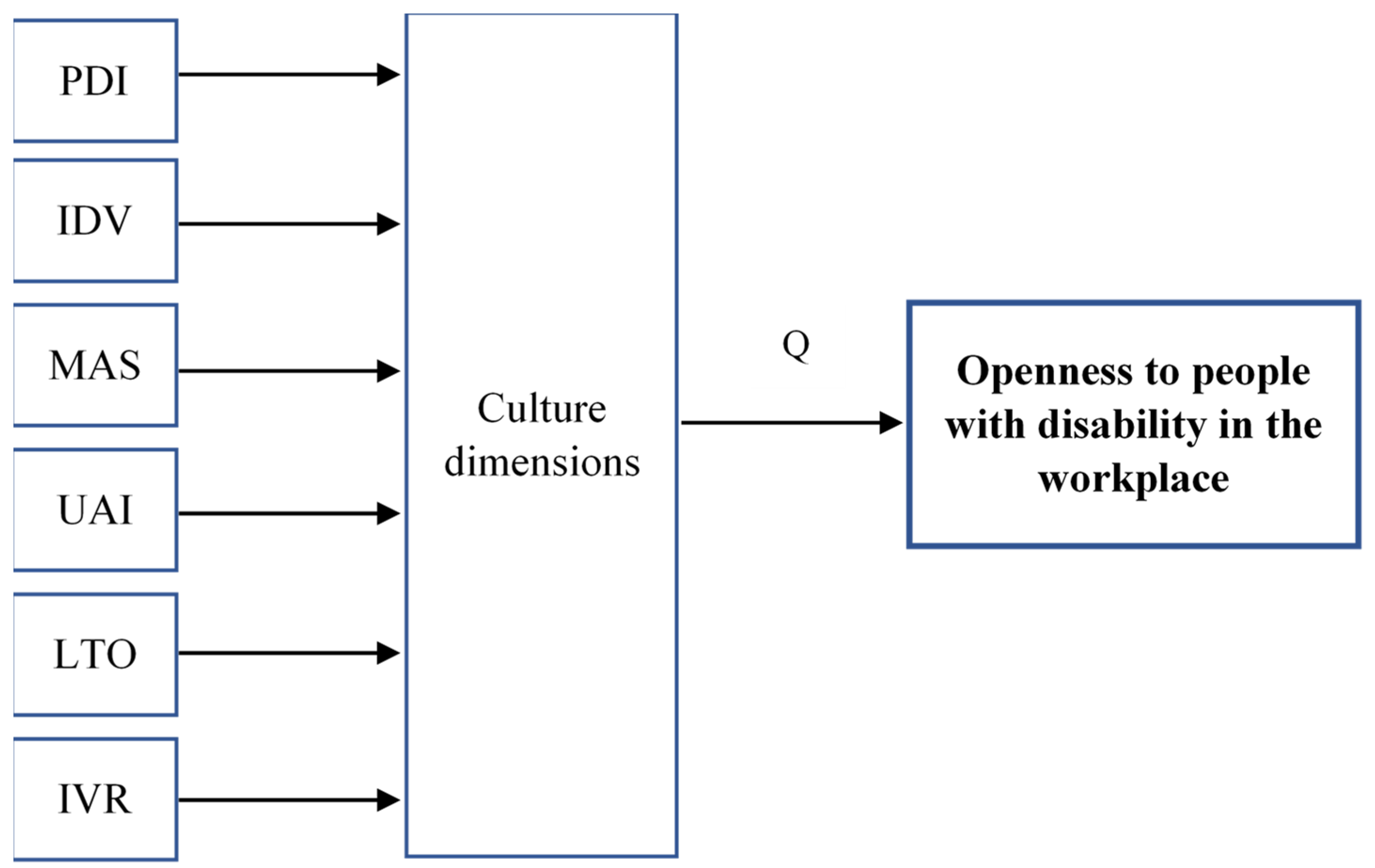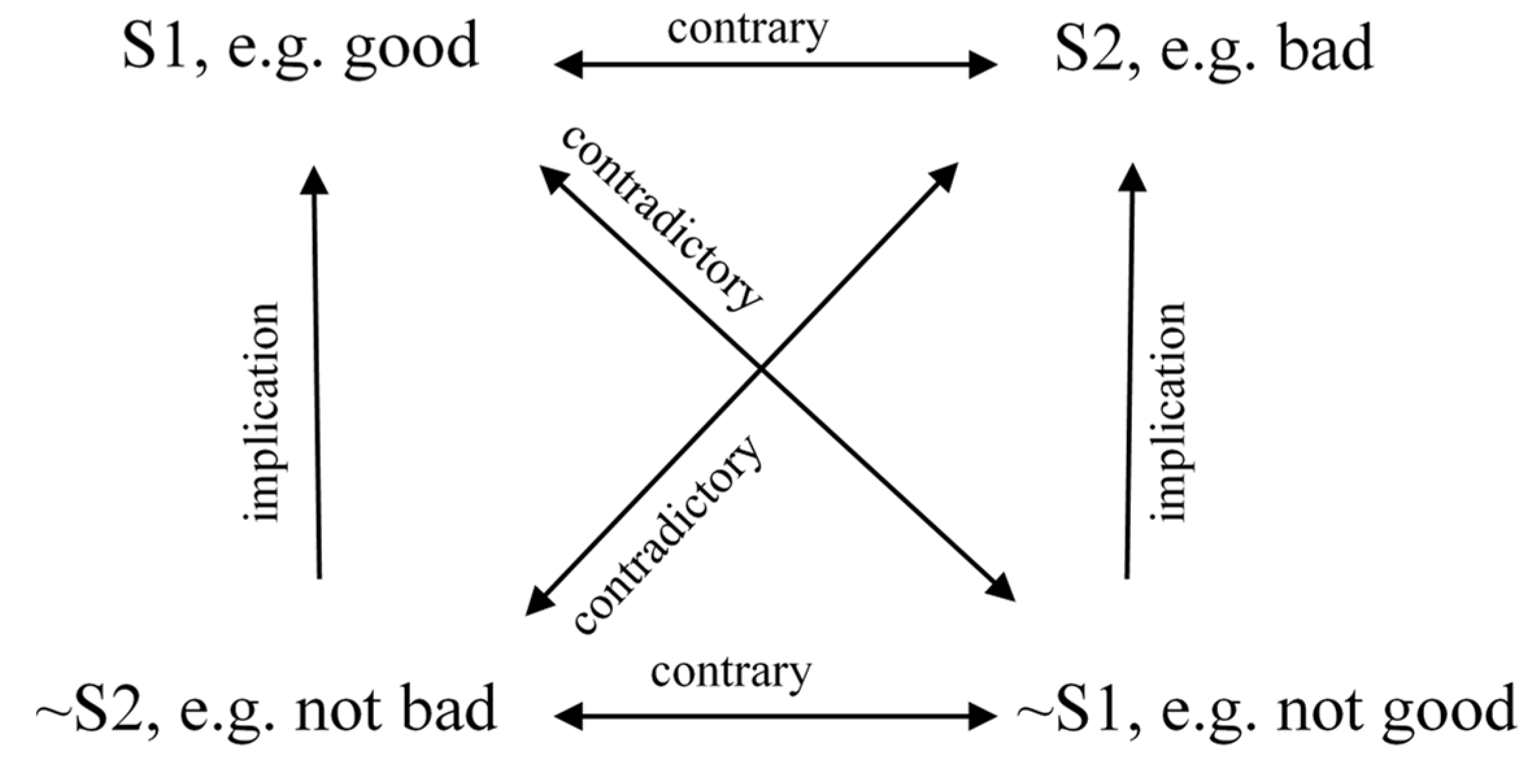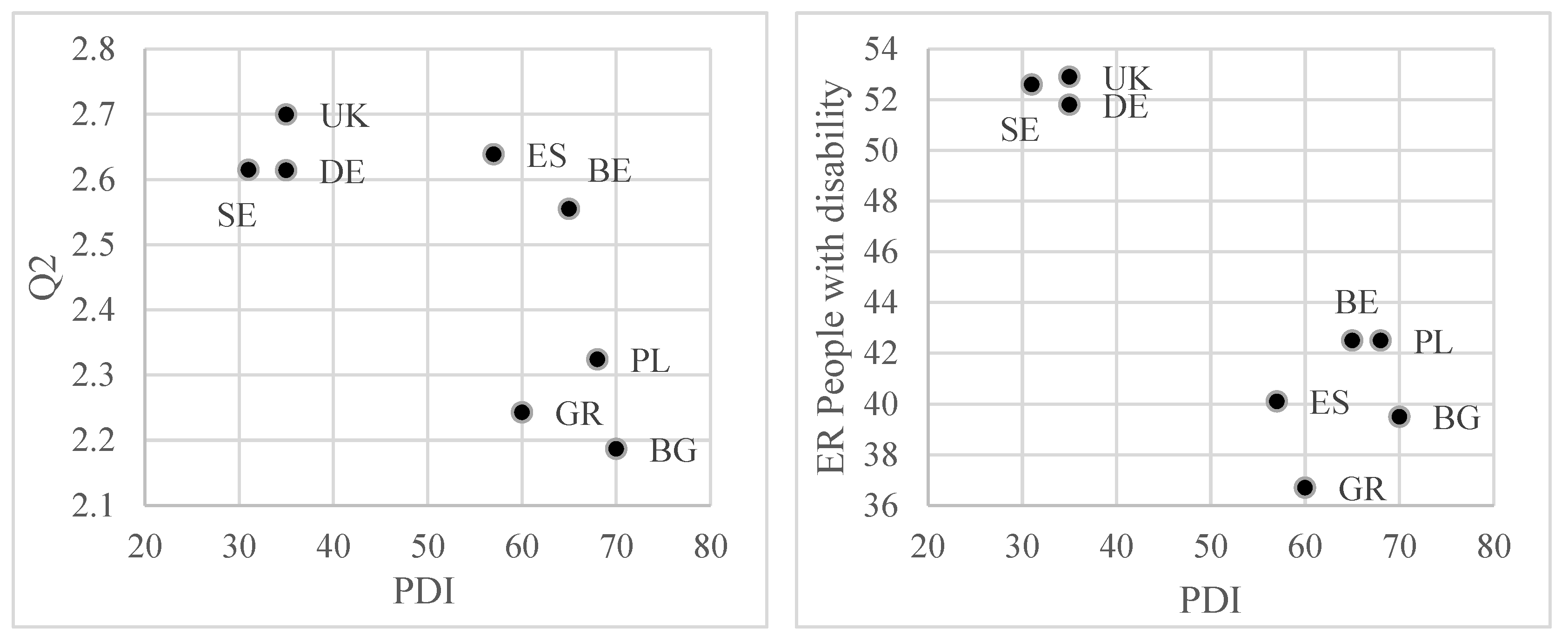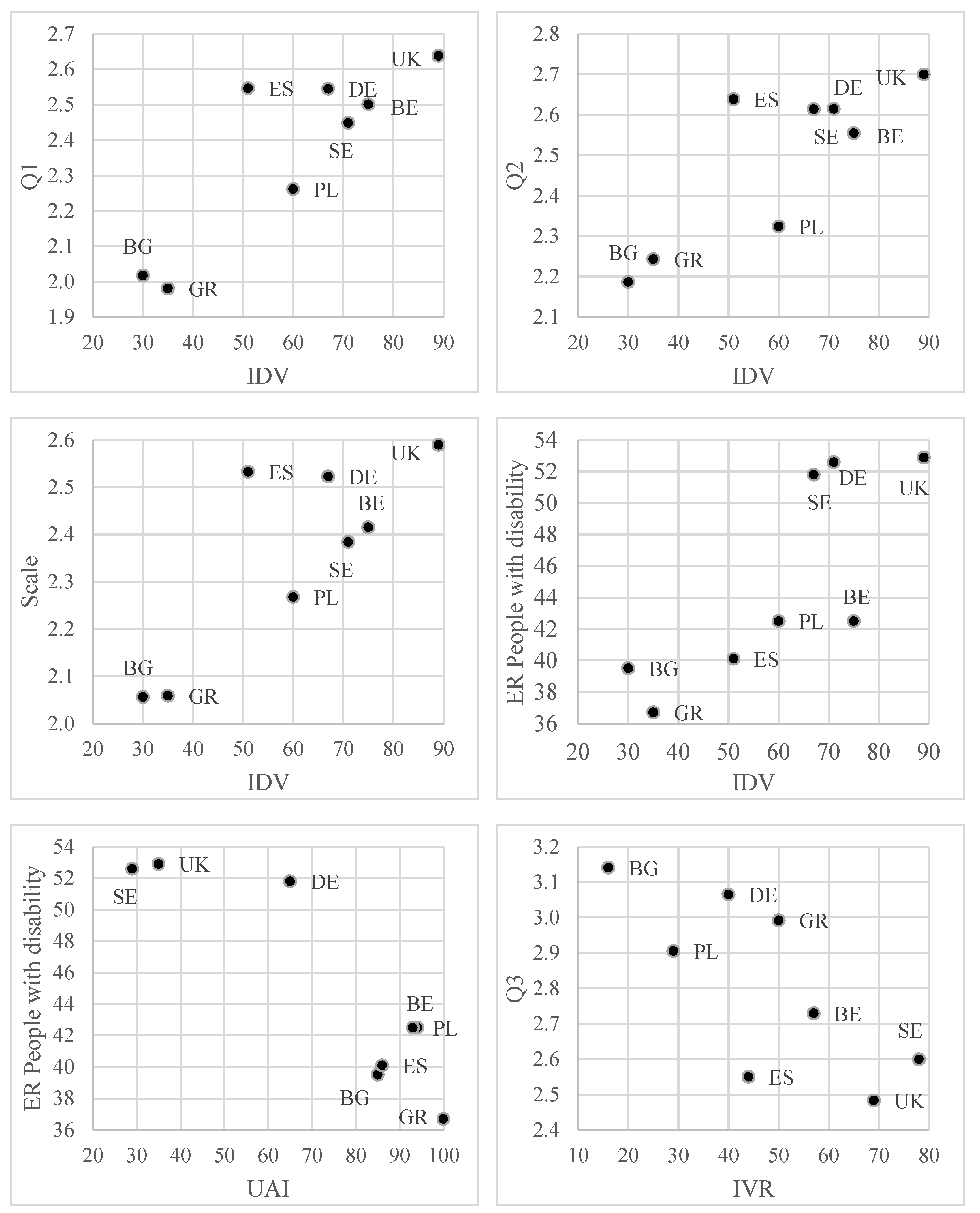Diversity of Perceptions of Disability in the Workplace vs. Cultural Determinants in Selected European Countries
Abstract
:1. Introduction
2. Materials and Methods
2.1. Data Collection and Research Sample
- Q1: In your opinion, does your country carry out an effective policy that allows for full integration of people with disability?
- Q2: In your opinion, is there a social atmosphere of understanding the needs and possibilities of people with disability in your country?
- Q3: Do you think that people with disability who have a job should have special employee privileges, e.g., a shorter working day, longer holidays, etc., in your country?
- Q4: Do you think that employers in your country have sufficient knowledge of how to employ a person with disability and organise his/her work?
2.2. Methods of Data Analysis
3. Results
3.1. Semiotic Research
3.2. Influence of Culture Dimensions on the Perception of People with Disability in the Workplace and Their Employability
4. Discussion
5. Conclusions
Author Contributions
Funding
Institutional Review Board Statement
Informed Consent Statement
Data Availability Statement
Conflicts of Interest
Appendix A
| Variables | Country | |||||||
|---|---|---|---|---|---|---|---|---|
| BG | DE | UK | ES | BE | GR | PL | SE | |
| PDI | 70 | 35 | 35 | 57 | 65 | 60 | 68 | 31 |
| IDV | 30 | 67 | 89 | 51 | 75 | 35 | 60 | 71 |
| MAS | 40 | 66 | 66 | 42 | 54 | 57 | 64 | 5 |
| UAI | 85 | 65 | 35 | 86 | 94 | 100 | 93 | 29 |
| LTO | 69 | 83 | 51 | 48 | 82 | 45 | 38 | 53 |
| IVR | 16 | 40 | 69 | 44 | 57 | 50 | 29 | 78 |
| Q1 | 2.02 | 2.54 | 2.64 | 2.55 | 2.50 | 1.98 | 2.26 | 2.45 |
| Q2 | 2.19 | 2.61 | 2.70 | 2.64 | 2.55 | 2.24 | 2.32 | 2.61 |
| Q3 | 3.14 | 3.07 | 2.48 | 2.55 | 2.73 | 2.99 | 2.91 | 2.60 |
| Q4 | 1.96 | 2.41 | 2.43 | 2.42 | 2.19 | 1.95 | 2.22 | 2.09 |
| Scale | 2.06 | 2.52 | 2.59 | 2.53 | 2.42 | 2.06 | 2.27 | 2.38 |
| ER People with disability | 39.5 | 51.8 | 52.9 | 40.1 | 42.5 | 36.7 | 42.5 | 52.6 |
References
- Burke, J.; Bezyak, J.; Fraser, R.T.; Pete, J.; Ditchman, N.; Chan, F. Employers’ Attitudes Towards Hiring and Retaining People with Disabilities: A Review of the Literature. Aust. J. Rehabil. Couns. 2013, 19, 21–38. [Google Scholar] [CrossRef]
- Copeland, J.; Chan, F.; Bezyak, J.; Fraser, R.T. Assessing cognitive and affective reactions of employers toward people with disabilities in the workplace. J. Occup. Rehabil. 2010, 20, 427–434. [Google Scholar] [CrossRef] [PubMed]
- Gilbride, D.; Vandergoot, D.; Golden, K.; Stensrud, R. Development and Validation of the Employer Openness Survey. Rehabil. Couns. Bull. 2016, 49, 81–89. [Google Scholar] [CrossRef]
- Kaye, H.S.; Jans, L.H.; Jones, E.C. Why don’t employers hire and retain workers with disabilities? JOR 2011, 21, 526–536. [Google Scholar] [CrossRef] [PubMed] [Green Version]
- Luecking, R. Emerging employer views of people with disabilities and the future of job development. JVR 2008, 29, 3–13. [Google Scholar]
- McDonnall, M.C.; Crudden, A.; O’Mally, J. Predictors of employer attitudes toward people who are blind or visually impaired as employees. JVR 2015, 42, 41–50. [Google Scholar] [CrossRef]
- Strindlund, L.; Abrandt-Dahlgren, M.; Ståhl, C. Employers’ views on disability, employability, and labor market inclusion: A phenomenographic study. Disabil. Rehabil. 2019, 41, 2910–2917. [Google Scholar] [CrossRef] [PubMed] [Green Version]
- Unger, D.D. Employers’ Attitudes Toward Persons with Disabilities in the Workforce. Focus Autism Other Dev. Disabl. 2016, 17, 2–10. [Google Scholar] [CrossRef]
- Kuznetsova, Y.; Yalcin, B. Inclusion of persons with disabilities in mainstream employment: Is it really all about the money? A case study of four large companies in Norway and Sweden. Disabil. Soc. 2017, 32, 233–253. [Google Scholar] [CrossRef]
- Schneider, J.; Dutton, J. Attitudes Towards Disabled Staff and the Effect of the National Minimum Wage: A Delphi survey of employers and disability employment advisors. Disabil. Soc. 2002, 17, 283–306. [Google Scholar] [CrossRef]
- Bonaccio, S.; Connelly, C.E.; Gellatly, I.R.; Jetha, A.; Martin Ginis, K.A. The Participation of People with Disabilities in the Workplace Across the Employment Cycle: Employer Concerns and Research Evidence. J. Bus. Psychol. 2020, 35, 135–158. [Google Scholar] [CrossRef] [PubMed] [Green Version]
- Breen, J.S. Attitudes Toward Employees with Disabilities: A Systematic Review of Self-Report Measures. Austr. J. Rehabil. Couns. 2018, 24, 67–87. [Google Scholar] [CrossRef]
- Louvet, E. Social judgment toward job applicants with disabilities: Perception of personal qualities and competences. Rehabil. Psychol. 2007, 52, 297–303. [Google Scholar] [CrossRef]
- McLaughlin, M.E.; Bell, M.P.; Stringer, D.Y. Stigma and Acceptance of Persons With Disabilities. Group Organ. Manag. 2016, 29, 302–333. [Google Scholar] [CrossRef]
- Popovich, P.M.; Scherbaum, C.A.; Scherbaum, K.L.; Polinko, N. The assessment of attitudes toward individuals with disabilities in the workplace. J. Psychol. 2003, 137, 163–177. [Google Scholar] [CrossRef] [PubMed]
- Vornholt, K.; Uitdewilligen, S.; Nijhuis, F.J.N. Factors affecting the acceptance of people with disabilities at work: A literature review. J. Occup. Rehabil. 2013, 23, 463–475. [Google Scholar] [CrossRef] [PubMed]
- Brostrand, H.L. Tilting at windmills: Changing attitudes toward people with disabilities. J. Rehabil. 2006, 72, 4–9. [Google Scholar]
- Fujimoto, Y.; Rentschler, R.; Le, H.; Edwards, D.; Härtel, C.E.J. Lessons Learned from Community Organizations: Inclusion of People with Disabilities and Others. Brit. J. Manag. 2014, 25, 518–537. [Google Scholar] [CrossRef]
- Giermanowska, E.; Racław-Markowska, M.; Szawarska, D. Employing People with Disabilities. Good Organisational Practices and Socio-Cultural Conditions; Palgrave Macmillan: Cham, Switzerland, 2020; ISBN 3030245519. [Google Scholar]
- Gröschl, S. Presumed Incapable. Cornell Hosp. Q. 2013, 54, 114–123. [Google Scholar] [CrossRef]
- Kuznetsova, Y.; Yalcin, B.; Priestley, M. Labour Market Integration and Equality for Disabled People: A Comparative Analysis of Nordic and Baltic Countries. Soc. Policy Adm. 2017, 51, 577–597. [Google Scholar] [CrossRef]
- Meyer, H.-D. Culture and Disability: Advancing Comparative Research. Comp. Sociol. 2010, 9, 157–164. [Google Scholar] [CrossRef]
- Trezzini, B.; Schuller, V.; Schüpbach, S.; Bickenbach, J. Environmental barriers to and facilitators of labour market participation as experienced by disabled people living in Switzerland. Disabil. Soc. 2020, 36, 925–951. [Google Scholar] [CrossRef]
- Saussure, F.d.; Bally, C.; Sechehaye, A.; Riedlinger, A.; de Mauro, T.; Calvet, L.-J. Cours de Linguistique Générale, Critique ed.; Payot et Rivages: Paris, France, 1995; ISBN 2-228-88942-3. [Google Scholar]
- Hofstede, G. Culture and Organizations. Int. Stud. Manag. Organ. 1980, 10, 15–41. [Google Scholar] [CrossRef]
- Hofstede, G.; Hofstede, G.J.; Minkov, M. Cultures and Organizations. Software of the Mind: Intercultural Cooperation and Its Importance for Survival, Revised and expanded 3rd ed.; McGraw-Hill: New York, NY, USA, 2010; ISBN 0071664181. [Google Scholar]
- Hofstede, G. Dimensionalizing Cultures: The Hofstede Model in Context. Online Read Psychol. Cult. 2011, 2, 8. [Google Scholar] [CrossRef]
- Gesteland, R.R. Cross-Cultural Business Behavior. Marketing, Negotiating, and Managing Across Cultures, 2nd ed.; Copenhagen Business School Press: Copenhagen, Denmark, 1999; ISBN 978-8716134288. [Google Scholar]
- House, R.J.; Hanges, P.J.; Javidan, M.; Dorfman, P.W.; Gupta, V. (Eds.) Culture, Leadership, and Organizations. The GLOBE Study of 62 Societies; Sage Publications: Thousand Oaks, CA, USA, 2004; ISBN 978-0761924012. [Google Scholar]
- Schwartz, S.H. An Overview of the Schwartz Theory of Basic Values. Online Read Psychol. Cult. 2012, 2, 11. [Google Scholar] [CrossRef]
- Kwiatkowska-Ciotucha, D.; Załuska, U.; Grześkowiak, A. Osoby z Niepełnosprawnością na Otwartym Rynku Pracy. Bariery Skutecznej Inkluzji w Miejscu Pracy; Publishing House of Wrocław University of Economics: Wrocław, Poland, 2020; ISBN 978-83-7695-806-4. [Google Scholar]
- Grammenos, S. Europe 2020 Data & People with Disabilities—Tables (EU SILC 2017). Available online: https://www.disability-europe.net/downloads/1045-europe-2020-data-people-with-disabilities-tables-eu-silc-2017 (accessed on 23 May 2020).
- Lotman, Y.M.; Uspensky, B.A.; Mihaychuk, G. On the Semiotic Mechanism of Culture. New Lit. Hist. 1978, 9, 211–232. [Google Scholar] [CrossRef] [Green Version]
- Pietraszko, S. O sferze aksjosemiotycznej. In Problemy Teoretyczne i Metodologiczne Badań Stylu Życia; Siciński, A., Ed.; IFiS PAN: Warszawa, Poland, 1980; pp. 53–75. [Google Scholar]
- Alexander, M. Codes and contexts: Practical semiotics for the qualitative researcher. In Market Research Society Conference; The Market Research Society: London, UK, 2000; pp. 139–146. [Google Scholar]
- Polak, K.; Żurawicka-Koczan, M. Semiotic approach in evaluation of public interventions. In Evaluation at Strategic Level of Governance; Haber, A., Szałaj, M., Eds.; Polish Agency for Enterprise Development; Ministry of Regional Development: Warsaw, Poland, 2011; pp. 121–133. ISBN 978-83-7633-011-2. [Google Scholar]
- Evans, M.; Harvey, M. Decoding Competitive Propositions: A Semiotic Alternative to Traditional Advertising Research. Int. J. Mark. Res. 2018, 43, 1–12. [Google Scholar] [CrossRef] [Green Version]
- Greimas, A.J. Éléments d’une grammaire narrative. L’Homme 1969, 9, 71–92. [Google Scholar] [CrossRef]
- Corso, J.J. What Does Greimas’s Semiotic Square Really Do? Mosaic 2014, 47, 69–89. [Google Scholar] [CrossRef]
- Rossolatos, G. Applications implications and limitations of the semiotic square for analyzing advertising discourse and discerning alternative brand futures. Signs-Int. J. Semiot. 2012, 6, 1–47. [Google Scholar] [CrossRef]
- Hébert, L. An Introduction to Applied Semiotics. Tools for Text and Image Analysis; Routedge Taylor & Francis Group: New York, NY, USA, 2020; ISBN 9780367351120. [Google Scholar]
- STATISTICA (Data Analysis Software System), Version 12; StatSoft, Inc.: Tulsa, OK, USA, 2014.
- IBM SPSS Statistics Base 26; IBM Corp.: Armonk, NY, USA, 2019.
- Floch, J.-M. Semiotics, Marketing, and Communication. Beneath the Signs, the Strategies; Palgrave: New York, NY, USA, 2001; ISBN 033376014X. [Google Scholar]
- Chandler, D. Semiotics. The Basics, 2nd ed.; Routledge: London, UK; New York, NY, USA, 2007; ISBN 9780415363754. [Google Scholar]
- Lévi-Strauss, C. Anthropologie Structurale; Plon: Paris, France, 2005; ISBN 978-2266139311. [Google Scholar]
- Załuska, U.; Grześkowiak, A.; Kozyra, C.; Kwiatkowska-Ciotucha, D. Ambassador of People with Disabilities in the Workplace-Conducive Demographic and Professional Characteristics. Int. J. Environ. Res. Public Health 2020, 17, 7036. [Google Scholar] [CrossRef] [PubMed]
- DeVellis, R.F. Scale Development. Theory and Applications, 4th ed.; SAGE: Los Angeles, CA, USA, 2017; ISBN 9781506341569. [Google Scholar]





| Variable | Culture Dimension | |||||
|---|---|---|---|---|---|---|
| PDI | IDV | MAS | UAI | LTO | IVR | |
| Q1 | −0.619 | 0.860 * | 0.053 | −0.553 | 0.226 | 0.548 |
| Q2 | −0.734 * | 0.821 * | −0.078 | −0.640 | 0.179 | 0.684 |
| Q3 | 0.428 | −0.659 | 0.260 | 0.523 | 0.323 | −0.754 * |
| Q4 | −0.455 | 0.653 | 0.394 | −0.322 | 0.085 | 0.202 |
| Scale | −0.628 | 0.815 * | 0.121 | −0.529 | 0.175 | 0.503 |
| ER People with disability | −0.897 * | 0.798 * | −0.124 | −0.903 * | 0.208 | 0.582 |
| Culture Dimension | Variable with Significant Correlation | Direction of Influence | Association |
|---|---|---|---|
| PDI | Q2 | (−) | The greater the power distance, the lower the social openness to the needs and possibilities of people with disability. |
| ER People with disability | (−) | The greater the power distance, the lower the employment rate of people with disability. | |
| IDV | Q1 | (+) | The higher the individualism of society, the more adapted the social policy is to the needs and expectations of people with disability. |
| Q2 | (+) | The higher the individualism of society, the greater the social openness to the needs and possibilities of people with disability. | |
| Scale | (+) | The higher the individualism of society, the better the atmosphere and the greater the understanding of the needs and possibilities of people with disability. | |
| ER People with disability | (+) | The higher the individualism of society, the higher the employment rate of people with disability. | |
| UAI | ER People with disability | (−) | The greater the uncertainty avoidance, the lower flexibility in action and the lower the willingness to employ people with disability. |
| IVR | Q3 | (−) | The greater the indulgence, the lesser the approval of additional privileges for people with disability. |
Publisher’s Note: MDPI stays neutral with regard to jurisdictional claims in published maps and institutional affiliations. |
© 2022 by the authors. Licensee MDPI, Basel, Switzerland. This article is an open access article distributed under the terms and conditions of the Creative Commons Attribution (CC BY) license (https://creativecommons.org/licenses/by/4.0/).
Share and Cite
Kwiatkowska-Ciotucha, D.; Załuska, U.; Kozyra, C.; Grześkowiak, A.; Żurawicka, M.; Polak, K. Diversity of Perceptions of Disability in the Workplace vs. Cultural Determinants in Selected European Countries. Int. J. Environ. Res. Public Health 2022, 19, 2058. https://doi.org/10.3390/ijerph19042058
Kwiatkowska-Ciotucha D, Załuska U, Kozyra C, Grześkowiak A, Żurawicka M, Polak K. Diversity of Perceptions of Disability in the Workplace vs. Cultural Determinants in Selected European Countries. International Journal of Environmental Research and Public Health. 2022; 19(4):2058. https://doi.org/10.3390/ijerph19042058
Chicago/Turabian StyleKwiatkowska-Ciotucha, Dorota, Urszula Załuska, Cyprian Kozyra, Alicja Grześkowiak, Marzena Żurawicka, and Krzysztof Polak. 2022. "Diversity of Perceptions of Disability in the Workplace vs. Cultural Determinants in Selected European Countries" International Journal of Environmental Research and Public Health 19, no. 4: 2058. https://doi.org/10.3390/ijerph19042058
APA StyleKwiatkowska-Ciotucha, D., Załuska, U., Kozyra, C., Grześkowiak, A., Żurawicka, M., & Polak, K. (2022). Diversity of Perceptions of Disability in the Workplace vs. Cultural Determinants in Selected European Countries. International Journal of Environmental Research and Public Health, 19(4), 2058. https://doi.org/10.3390/ijerph19042058






